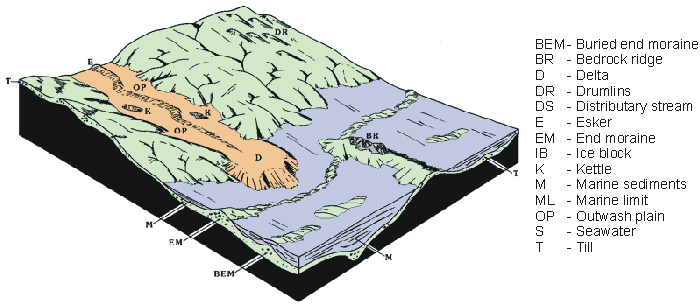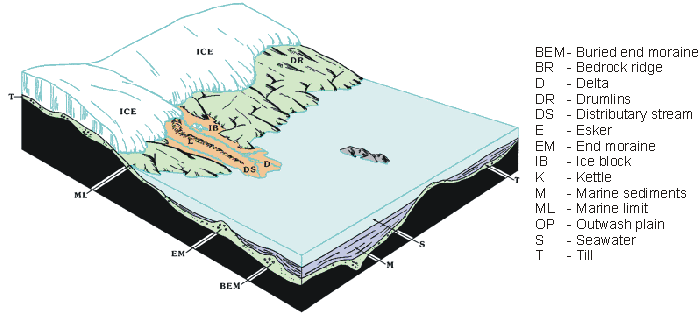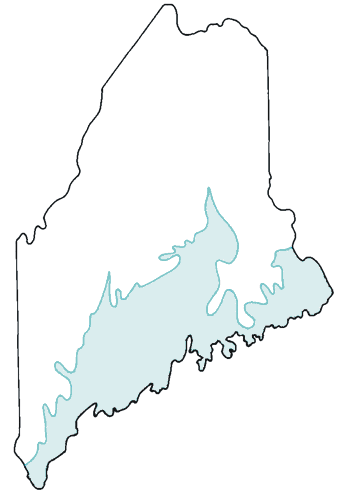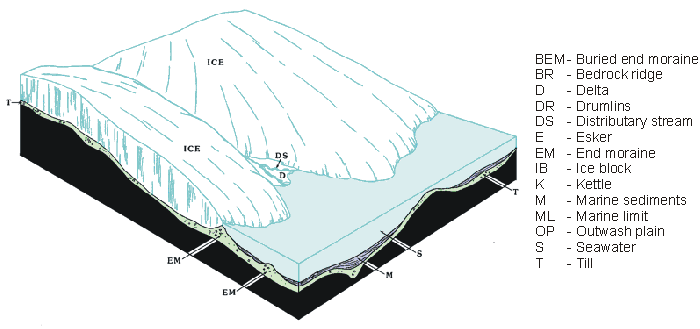DACF Home → Bureaus & Programs → Maine Geological Survey → Maps, Publications and Online Data → Using Geologic Maps → Reconnaissance Surficial Geology Maps → Explanation
Explanation of Information Shown on Reconnaissance Surficial Geology Maps
EXPLANATION OF UNITS
| Symbol | Geologic Unit | Materials | Topography | Origin |
|---|---|---|---|---|
| Qal | Stream alluvium (floodplain and stream-terrace deposits) | Sand, gravel, and silt. Low to high permeability. poor to good drainage. Permeability and drainage generally are better in stream-terrace deposits than in modern flood-plain sediments. | Flat to gently sloping. | Deposited on flood plains and stream beds by postglacial streams. Unit may also include minor alluvial fan deposits at mouths of valleys. |
| Qs | Swamp and tidal-marsh deposits | Peat, silt, clay and sand. Poor drainage. | Flat. | Formed by accumulation of sediments and organic material in depressions and other poorly drained areas. |
| Qbd | Beach and dune deposits | Sand and gravel. High permeability. Materials are well drained, but water table is close to surface. | Low ridges and mounds, or sloping surface. | Occurs along modern ocean and lake shores. Includes beach sediments formed by wave and current action, and windblown sand derived from these deposits. |
| Qe | Eolian deposits | Sand. Moderate to high permeability. Good drainage. | Dune ridges and mounds or blanket deposit that conforms to surface of underlying unit. | Windblown sand. Derived from wind erosion of glacial sediments and deposited in late-glacial to postglacial time. |
| Qta | Talus deposits | Large angular rock fragments. | Steeply sloping rock piles at the bottoms of cliffs. | Formed by the accumulation of rock fragments that break loose from a cliff and fall to the slope below. |
| Ql | Glacial-lake bottom deposits | Silt, clay, and sand, commonly as thin inter-stratified layers of various particle sizes. Low to moderate permeability. Poor to fair drainage. | Flat to gently sloping except where dissected by modern streams. | Composed largely of sediments that washed out of glacial ice and accumulated on the floors of glacial lakes. Map unit may also include a few non-glacial lake bottom deposits. |
| Qbl | Glacial-lake beach deposits | Gravel and sand. Typically thin and of limited extent. High permeability. Good drainage. | Low ridges or sloping surface. May be associated with wave-cut benches on hill sides. | Formed by wave erosion of till or other materials along shores of glacial lakes. Lakes have since lowered or drained. |
| Qps, Qp | Glacial-marine deposits (Presumpscot Formation) | Silt, clay, and sand. Commonly a clayey silt, but sand is very abundant at the surface in some places. Locally fossiliferous. Map unit includes small areas of till, sand, and gravel that are not completely covered by marine sediment. Qps: Mostly sand, but may be underlain by silt and clay. Moderate to high permeability. Fair to good drainage. Qp: Mostly silt and clay. Low permeability. Poor drainage. | Flat to gently sloping except where dissected by modern streams. Commonly has a branching network of steep-walled stream gullies. | Composed of sediments that washed out of the Late Wisconsinan glacier and accumulated on the ocean floor. Formed during late-glacial time, when relative sea level was higher than at present. |
| Qbm | Emerged marine-beach deposits | Gravel and sand. High permeablility. Good drainage. Typically thin and of limited extent. | Low ridges or sloping surface. May be associated with wave-cut benches on hillsides. | Formed by wave erosion of till or other materials during late-glacial time, when relative sea level was higher than at present. |
| Qgo, Qg | Glacial-stream deposits | Sand and gravel. May include minor till. Commonly overlapped or entirely buried by glacial-marine deposits in the coastal lowland. Qgo: High permeability. Good drainage. Qg: Moderate to high permeability. Good drainage. | Qgo: Flat (outwash deposits). Qg: Flat-topped landforms, bounded in part by steep sides (kame terraces and kame deltas); hummocky terrain with hills (kames) and depressions (kettles); or ridges (eskers). | Deposited by meltwater streams and currents during melting of the Late Wisconsinan glacier. Qgo: Outwash plains and outwash deltas. Deposited beyond the ice margin. Qg: Kames, eskers, and marine or glacial-lake deltas - all formed adjacent to glacial ice (ice-contact deposits). |
| Qmg, Qmh, Qmt, Qm | End-moraine deposits | Till and/or sand and gravel. Commonly overlain by glacial-marine deposits in coastal areas. Permeability and drainage are highly variable, even over short distances in a single moraine. Qmg: Composed mostly of sand and gravel. Qmh: Composed of till, sand, and gravel. Qmt: Composed mostly of till. Qm: Composition not specified. | Ridges. Commonly arcuate, discontinuous, and in groups. Size range: 3-75 ft. high, 20-1,000 ft. wide, and 100 ft. to several miles long. Qmh: Hummocky topography. | Deposited in marginal zone of the Late Wisconsinan glacier, by glacial ice (till) and/or meltwater streams emerging from the ice (sand and gravel). |
| Qt | Till | Hetergeneous mixture of sand, silt, clay, and stones. Stratification is rare. Includes two varieties: basal till and ablation till. Basal till is fine-grained and very compact, with low permeability and poor drainage. Ablation till is loose, sandy, and stony, with moderate permeability and fair to good drainage. Unit generally overlies bedrock, but may overlie or include sand and gravel. | Commonly a blanket deposit that conforms to bedrock surface. Also forms glacially streamlined hills (including drumlins), where till thickness locally exceeds 100 feet. | Deposited directly by glacial ice. |
GEOLOGIC SYMBOLS
| Bedrock outcrops | Dots show locations of individual outcrops. Ruled pattern indicates areas of many outcrops and/or thin surficial deposits (generally less than 10 ft. thick). Symbol "rk" indicates areas of barren ledge. Outcrops mapped largely by interpretation of aerial photography in off-road areas. |
| Artificial fill | Composed of till, sand and gravel, rock or various man-made materials (mainly trash in large dumps and landfills). |
| Contact | Boundary between adjacent map units. Dashed where inferred. |
| Scarp | Separates stream terrace from modern flood plain and adjacent terraces from each other. Hachures on downslope side. |
| Drumlin | Glacially streamlined hill that has been elongated in direction of ice movement. Symbol shows direction of long axis. Generally composed of till and/or bedrock (rarely sand and gravel). Till is very thick in parts of many drumlins. |
| Glacial striation locality | Point of observation at tip of arrow. Arrow indicates ice-movement direction as inferred from striations (scratches on bedrock caused by glacial abrasion). |
| Crescentic mark locality | Point of observation at tip of arrow. Arrow indicates ice-movement direction as inferred from crescentic marks on bedrock surface. |
| Grooved till surface | Symbols show lengths and directions of narrow ridges carved in till by flow of glacial ice. |
| Area of many large boulders | |
| Cirque | A steep-walled, half-bowl shaped basin. Formed by glacial erosion in high mountainous areas of Maine. |
| End moraine | Ridge of till or sand and gravel deposited at margin of glacier. Barbs point in direction of ice movement. Symbol is used in part to indicate moraines that are mostly buried by water-laid glacial sediment, as well as moraines that are too narrow to be outlined by a contact line at the scale of the map. |
| Dip direction of delta foreset beds | Number is approximate altitude in feet of contact between topset and foreset beds, which marks former position of sea level or glacial lake level (generally sea level in coastal Maine). Point of observation at tip of arrow. |
| Dip direction of cross bedding in glacial-stream deposits | Indicates direction of flow of glacial meltwater streams. |
| Crest of esker | Shows trend of sand and gravel ridge that was deposited in meltwater tunnel beneath glacier. Chevrons point in direction of meltwater flow. |
| Kettle | Depression created by melting of large mass of buried glacial ice and collapse of overlying sediments. |
| Meltwater channel | Channel eroded by glacial meltwater stream. Arrow indicates known or probable direction of stream flow. |
| Till or sand and gravel pit | |
| Bedrock quarry | |
| Source of dated sample | Symbols show collection site and laboratory sample number of 14-C dated shells, wood, or other organic material. |
SEQUENCE OF GLACIAL RECESSION AND DEPOSITION OF GLACIAL MATERIALS

11,000 years ago: Glacier had disappeared from central and southern Maine. Uplift of land had caused sea to retreat.

13,000 years ago: Glacier was receding rapidly and much of southern Maine was ice-free. Land was still depressed from weight of ice, resulting in extensive marine submergence of lowland areas.

Marine limit: Shows region of Maine covered by sea water during period of maximum inundation about 13,000 years ago.

13,500 years ago: Continental glacier covered most of Maine but was receding from the coastal lowland. Sea was in contact with ice margin.
Last updated on April 25, 2012